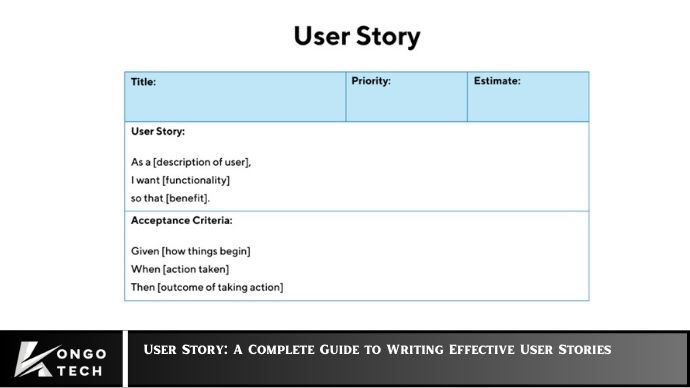In the world of agile development, one of the most important concepts is the user story. User stories are the foundation of agile frameworks, acting as the key to clear communication between stakeholders, developers, and product owners. But what exactly is a user story, and how can you write one that truly captures the user’s needs and drives product development?
In this guide, we’ll break down everything you need to know about user stories, from their purpose and structure to real-life examples and best practices for writing them effectively. Whether you’re a product manager, developer, or designer, understanding user stories is crucial to creating software that provides value to users.
What is a User Story?
A user story is a brief, clear description of a feature or functionality that a product or service must have from the user’s perspective. The user story format focuses on understanding the user’s needs, which allows teams to prioritize development tasks based on the value those features will deliver.
A user story typically follows this simple structure:
As a [type of user], I want [an action] so that I can [achieve a goal].
For example:
- As a mobile app user, I want to receive push notifications for new messages so that I never miss an important update.
This format ensures that the development team understands not just what the user wants to do, but why it matters. It also allows for prioritizing user stories based on their potential impact.
Why Are User Stories Important?
User stories are important for several reasons:
- They ensure the team understands the user’s needs: Instead of focusing on technical specifications, user stories help developers and designers focus on what the user really needs.
- They promote collaboration: User stories serve as a starting point for discussions between developers, business stakeholders, and customers.
- They help define scope: By keeping the focus on the user’s needs, user stories prevent feature creep and help prioritize work.
- They guide testing: The simple, goal-oriented structure of user stories helps define acceptance criteria and makes testing more straightforward.
User stories are a powerful way to ensure the product development cycle is focused on delivering real value to users. This focus helps teams stay agile, iterate quickly, and respond to user feedback effectively.
How to Write a User Story
Writing a good user story is an art, and there are a few key principles you should keep in mind when crafting one. Here’s how to write a user story that is clear, actionable, and valuable.
Step 1: Identify the User
The first part of the user story is to define who the user is. Are they a customer, an admin, a subscriber, or some other type of user? It’s important to be specific about the role of the user, because this will guide the rest of the story.
Example:
- As a user,
- As an administrator,
- As a customer,
- As a site visitor,
Step 2: Define the Action
Next, you need to define what the user wants to do. What action does the user want to take? This should be specific and tied to the user’s goals.
For example:
- I want to sign up for a newsletter.
- I want to add an item to my shopping cart.
- I want to track my fitness goals.
The action should be concise but clear enough for the development team to understand and implement.
Step 3: State the Goal or Benefit
Finally, describe the reason or goal behind the user’s action. Why does the user want to take this action? This is the key to understanding the value the feature will provide. The goal helps prioritize the user story by highlighting its importance.
For example:
- So that I can receive updates and stay informed.
- So that I can make a purchase later.
- So that I can monitor my health and stay motivated.
Complete Example:
- As a customer, I want to add an item to my shopping cart so that I can purchase it later.
This format is simple, direct, and valuable for both the team and the end user.
Best Practices for Writing Effective User Stories
To write high-quality user stories that provide real value, follow these best practices:
- Keep it Simple and Concise: A good user story is simple and focused. Avoid over-complicating it with unnecessary details. The goal is clarity.
- Focus on the User’s Need: The user story should be written from the perspective of the user, not from the perspective of the developer or business stakeholder.
- Use the INVEST Criteria: A popular method for evaluating the quality of user stories is the INVEST acronym, which stands for:
- Independent: The story can be worked on independently.
- Negotiable: There’s room for discussion and refinement.
- Valuable: The story provides value to the user.
- Estimable: The effort to complete the story can be estimated.
- Small: The story can be completed in a short time frame (typically one sprint).
- Testable: It can be tested to determine if it meets the user’s needs.
- Avoid Technical Details: Keep the focus on what the user needs, not on how to implement the feature. Technical details should come later in the conversation during implementation or task creation.
- Collaborate with Stakeholders: Involve end-users, product owners, and developers to ensure that the story reflects the user’s needs and expectations. Constant collaboration ensures the story is clear and achievable.
- Make It Testable: Define acceptance criteria for each user story to clarify what constitutes a “done” feature. This helps both developers and QA teams understand the scope and expectations of the story.
User Story Templates
Using templates can help streamline the process of writing user stories. Below are two templates to guide your writing.
Basic User Story Template:
As a [user type],
I want to [perform an action],
So that I can [achieve a goal].
Expanded User Story Template:
As a [user type],
I want to [perform an action],
So that I can [achieve a goal],
Given [any prerequisites or context],
When [the action occurs],
Then [the expected result].
This expanded template is especially useful when you need to clarify specific scenarios or conditions under which the user story is valid.
Examples of User Stories
Here are a few real-life examples to illustrate how user stories are used in different contexts.
E-Commerce Website
- As a customer, I want to receive an email confirmation after purchasing an item so that I can have a record of my transaction.
Mobile App for Fitness
- As a fitness enthusiast, I want to set daily step goals so that I can stay motivated to achieve my fitness objectives.
SaaS Platform
- As an admin user, I want to manage user access permissions so that I can ensure the security of the platform.
Educational Platform
- As a student, I want to download my course materials so that I can study offline.
Common Mistakes to Avoid When Writing User Stories
- Being Too Vague: If your user story is too broad, it will be difficult for the development team to understand the feature and its value. For example, “As a user, I want a better user experience” is too vague. Be specific.
- Including Technical Details: User stories should focus on user needs, not implementation. Technical details should be captured in tasks or technical specifications, not in the story itself.
- Overloading with Features: Avoid writing user stories that try to do too much. User stories should be small and manageable, not an all-encompassing feature request.
- Lack of Acceptance Criteria: Without clear acceptance criteria, it becomes difficult to know when a user story is complete. Acceptance criteria help guide development and testing.
May you also like it:
User Story How-to-Write Guide with Examples and Templates
Qualcomm Unveils Snapdragon 4 Gen 2: The Next-Gen Mobile Chip
SK hynix Starts Mass Production of Industry’s First 24GB LPDDR5X DRAM
Conclusion
User stories are a fundamental part of agile development, providing a clear and concise way to define user needs and prioritize work. By following the principles of simplicity, clarity, and user focus, you can craft user stories that guide your team in building meaningful features that deliver value. Always remember to keep the user at the center of the story, collaborate with stakeholders, and use templates and best practices to ensure success.
Writing effective user stories isn’t just about filling in a template; it’s about creating a shared understanding of what the user needs and why it matters. When done right, user stories not only improve communication within teams but also enhance the end-user experience, driving better product outcomes.
FAQs
What is the format of a user story?
The most common format for a user story is: “As a [user type], I want [an action] so that I can [achieve a goal].”
How do I break down large user stories?
Large user stories (also called epics) can be broken down into smaller, more manageable stories that can be worked on in one sprint or iteration.
What is the purpose of acceptance criteria?
Acceptance criteria define the conditions that must be met for a user story to be considered complete, ensuring that the story delivers the desired outcome.
How do I prioritize user stories?
User stories can be prioritized based on factors like user value, business goals, development complexity, and dependencies. Agile teams often use techniques like MoSCoW or the Fibonacci sequence to estimate and prioritize.
How can I ensure my user stories are valuable?
By focusing on the user’s needs, collaborating with stakeholders, and regularly reviewing the stories, you can ensure that each story provides clear value and is aligned with business goals.

